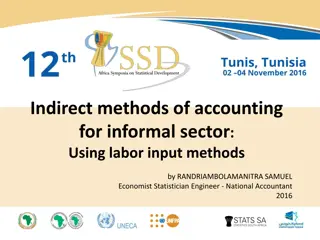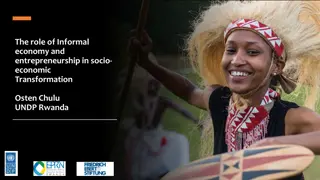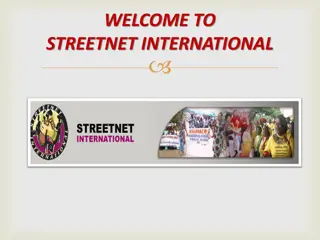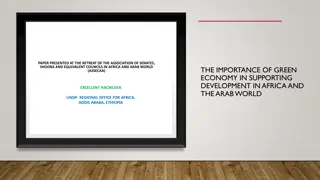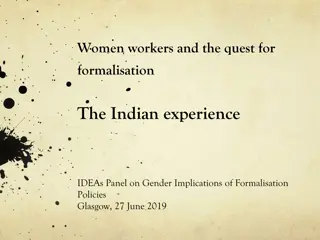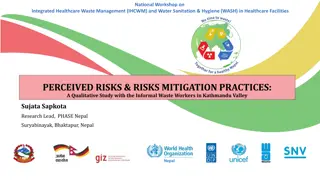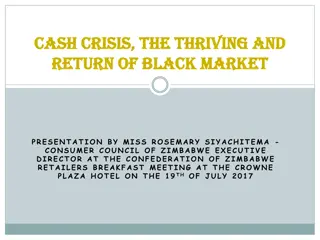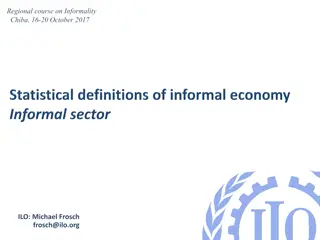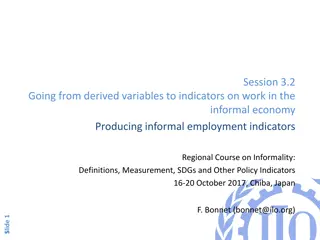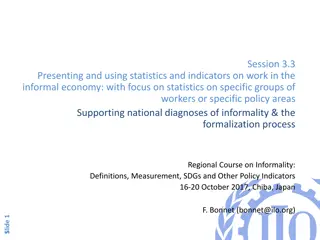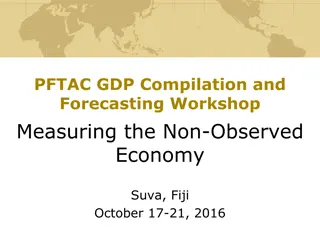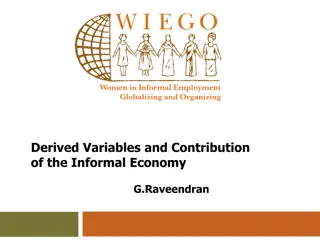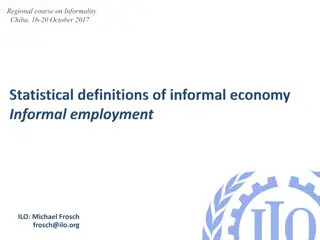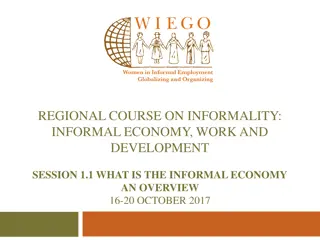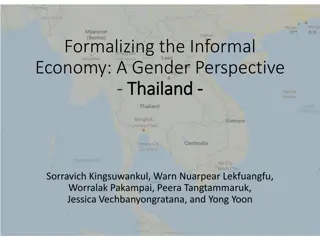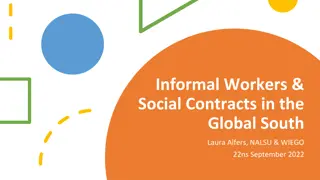Uniting Workers in Africa's Informal Economy: Challenges and Opportunities
Unionisation in the informal economy (IE) in Africa poses unique challenges and opportunities for workers. This presentation explores the growing presence of IE in developing countries, the gender dimension in unionisation, and the role of trade unions in addressing the specific needs of IE workers. It discusses the potential of IE for both development and exploitation, highlighting the importance of integrating women's issues and overcoming challenges such as operating outside legal frameworks. The objective is to discuss how unionism can effectively organise and support IE workers in Africa.
Download Presentation

Please find below an Image/Link to download the presentation.
The content on the website is provided AS IS for your information and personal use only. It may not be sold, licensed, or shared on other websites without obtaining consent from the author.If you encounter any issues during the download, it is possible that the publisher has removed the file from their server.
You are allowed to download the files provided on this website for personal or commercial use, subject to the condition that they are used lawfully. All files are the property of their respective owners.
The content on the website is provided AS IS for your information and personal use only. It may not be sold, licensed, or shared on other websites without obtaining consent from the author.
E N D
Presentation Transcript
Trade Union and organising the Informal Economy in Africa Roger Tsafack Nanfosso Roundtable II Exploring the Multiple Roles of Trade Unions in Africa Today Leiden, 10 September 2014
Summary Introduction Unionisation in informal economy (IE) in Africa Gender dimension in the IE unionisation
Introduction The IE is currently growing in both rural and urban areas of most developing countries. Even the industrialised countries witness a gradual rise of the IE within their labour markets. Around the World, about two thirds of all employees work in the IE; and almost the majority of the labour force in Africa.
Introduction The IE is now a reality in the context of globalisation and also a holder of great promises as far as its potential role for development is concerned. Some scholars and practitioners (pros) demonstrates its job potential and the dynamism it brings to the economy, and its role as a social stabiliser whereas some others (cons) consider it as a source of exploitation and social exclusion.
Introduction As concerns workers conditions, there is more and more agreement within the trade union movement about the need for providing appropriate responses that tackle their problems that assumes the creation of trade union. But the specificities of the IE constitute some challenges to be overcome.
Introduction These challenges are: A) the conception of IE as a survival strategy than a viable response to poverty alleviation and unemployment by the workers. B) they sometimes operate outside the legal, administrative and social framework. C) the ways of integrating women issues would be important.
Introduction Considering all these issues, the objective here is to discuss how unionism tackles the organisation of IE in Africa, trough two steps: Unionisation in the IE, Gender dimension in informal unionisation.
Unionisation in the IE in Africa The ILO defines a trade union organization as: An organization of employees usually associated beyond the confines of one enterprise, established for protecting or improving through collective action, the economic and social status of its members .
Unionisation in the IE in Africa But in the context of IE, the situation may be different because of the diversity of those working there. There was then no surprise to have an International Symposium on Trade Unions and the Informal Sector organised by the Bureau for Workers Activity (ACTRAV) of the ILO in Geneva, October 18-22, 1999.
Unionisation in the IE in Africa In general, two ways to organise IE workers: A) A traditional union extends its field of activity to include IE workers; or when a national trade union centre creates an organization for IE workers (Senegal, Burkina Faso) B) A new trade union is created specifically to organize IE workers (South Africa, Namibia, C te d Ivoire)
Unionisation in the IE in Africa In many countries, those workers have created associations and others same organisations that are officially registered and act as some kind of informal unionisation . And those organizations are known mainly under the name of Membership-based organizations of the very poor (MBOPs) .
Unionisation in the IE in Africa Types of organisation and primary strategies (Schurman and Eaton, 2012) Primary strategy Grassroots organizing and based building Types of organisation Unions, Memberships Based Organisations (MBOs), Community Based Organisations (CBOs), Cooperatives Unions, MBOs Collectives negotiations and representation Economic and livelihood development Policy, legal and rights advocacy Mobilisation and campaigning Social, welfare, training Cooperatives NGOs, CBOs, networks, alliances Networks, alliances, unions NGOs, CBOs
Unionisation in the IE in Africa Worker in IE usually organise to overcome business constraints like: high prices for inputs, low price for the goods produce, difficulties in gaining access to credit and service, threats of eviction by cities authorities, the risk of income losses deriving from unexpected events such as death or illness.
Unionisation in the IE in Africa Across less developed countries, operators in IE are organizing into unions, associations and cooperatives. There is a growing recognition among IE operators about the benefits of acting as a group rather than as individuals. The WIEGO database (WORD) reveals at least 190 IE associations in Africa, ranging from MBOPS to CBOs to co-operatives to NGOs to trade unions.
Unionisation in the IE in Africa Some trade unions in the IE in Ghana. Name Ghana Private Road Transport Union (GPRTU) General Agricultural Workers Union (GAWU) Timber and Woodworkers Union (TWU) Target Hired drivers, owner-drivers, vehicle drivers and paramilitary personnel engaged as guards Membership - - Peasant and landless farmers, farmers who hire out their labour, flywheel tractor operators, stone-quarrying workers and other self-employed rural workers. 12,000 among them 60 per cent women. Power chainsaw operators, firewood cutters, charcoal burners and the canoe carvers whose activities are carried out right in the forest. TWU includes the National Sawyers Association (NSA); Small-Scale Carpenters Association (SSCA); the Wood Working Machine Owners Association (WWMOA); the Cane and Rattan Workers Association (CRWA) Hairdressers and Beauticians Association (GHABA) that includes also barbers. A total of 48,000 people including 12,000 for NSA; 32,000 for SSCA; 3,000 for WWMOA; and 1,000 for CRWA 4,000 The Industrial and Commercial Workers Union (ICU) The Ghana Union of Professional Photographers (GUPP) Photographers 1,150
Unionisation in the IE in Africa Some trade unions in the IE in Kenya. Name Kenya Union of Food, Commercial and Allied Workers Kenya Shoe and Leather Workers Union Kenya Tailors and Textile Workers Union Kenya Building and Construction Union Membership 9,000 IS enterprises employing approximately 18,000 workers 5,000 IS entrepreneurs with 10,000 workers 20,000 IS entrepreneurs employing some 150,000 workers 10,000 establishments in the IS with 2,000 operators
Unionisation in the IE in Africa Some others IE unions include: Malawi: Malawi Union for the Informal Sector (MUFIS) => approximately 14,550 members in 2012, who work in as different IE as: home-based workers, street vendors, waste pickers, construction workers, domestic workers and small-scale tea farmers.
Unionisation in the IE in Africa Mozambique: Associacao dos Operadores e Trablhadores do Sector Informal (ASSOTSI) , for street vendors => 48,000 IE workers countrywide. Cameroon: National Street Vendors Association (ANESCAM) => 11,000 IE operators. Senegal: Informal and Rural Workers Federation (FETRI) => around 3,500 members, mainly women (the sale of fish and vegetables, retail sales, laundry services product transformation, horticulture, cattle raising).
Unionisation in the IE in Africa Some of their objectives: health insurance (sometimes social security and pension benefits coverage), domestic services and basic education, welfare assistance and negotiation with government and city authorities, vocational certification, contractor registration and reduction of contractor registration fees
Gender dimension in IE unions In Africa, nine to ten rural and urban workers have informal jobs, and this is especially the case for women and young people. In Sub-Saharan Africa, 84 % of women non-agricultural workers are informally employed compared with 63% of male non- agricultural workers. Street vendors, the majority of whom are women, represent a significant percentage of the workforce in the IE.
Gender dimension in IE unions Employment in the IE as % of total employment 100 Total Men Women Share in total employment (including agriculture) 90 80 70 60 50 40 30 20 10 0 Cameroon, Benin, Tanzania, Zambia, Africa, South 2002 2004 2005 2006 2011
Gender dimension in IE unions In 1995, the Self-Employed Women s Association (SEWA) of India and the international alliance of home-based workers (HomeNet) realised that they needed statistics for their lobbying activities. In 1997, representatives of SEWA and HomeNet joined other experts to form a global network called Women in Informal Employment: Globalising and Organising (WIEGO).
Gender dimension in IE unions Some IE women organisations include: Cameroon: Women Interface North South is an association that aims to promote the proactive and active participation of women in socio-political and economic activities. C te d Ivoire: SYNAFSI (National Union of Informal Sector Women) is a union for women in the IE working in markets and in rural village co-operatives.
Gender dimension in IE unions C te d Ivoire: Association 20,000 women for a bank created the first bank of women of C te d Ivoire, to formalise, coordinate capitalise and optimise savings efforts achieve in tontines and other circles of women and allowing access for greatest number to microcredit with a structure created by the same.
Gender dimension in IE unions Benin: Through a women s association called GBENONKPO, the cement workers union SYNTRAUCIB has organized women in 33 villages into women s cooperatives. It also helps to hold training seminars for rural women to develop income-generating skills such as conservation of food, soap- making and bee-keeping. The union held discussions with local authorities to organize a market every 5 days.
Gender dimension in IE unions South Africa: Self Employed Women s Union (SEWU), a South African COSATU affiliate.
Concluding remarks We have analyse the relationship between trade union and the IE. Three (3) key ideas can be highlighted: (i) IE workers are nowadays organised either themselves, or by traditional trade unions. (ii) these organisations are multiform: associations, MBOs/CBOs or cooperatives, etc. And like any union they act to protect and represent their members among others.
Concluding remarks (iii) gender dimension is a prominent aspect either inside existing organisations, or through specific organisation create by or for ladies. Of course, we are still lacking systematic and comprehensive data (statistics) exclusively devoted to informal unionisation all over the continent.



